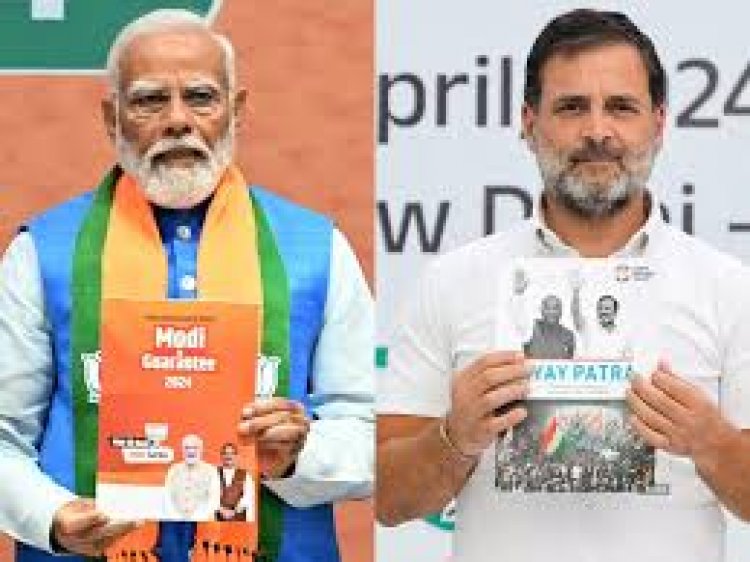BJP, Congress Manifestos: Comparison on National Security Related Issues
STORIES, ANALYSES, EXPERT VIEWS

Maj Gen Ashok K Mehta Retd. (military commentator) compares the election manifestos of the BJP and Congress on matters concerning national security.
BJP’s election manifesto
The “BJP’s election manifesto covers several aspects of defence and national security, albeit in a fragmented manner…… The party claims that there have been ‘zero major terror attacks in any city since 2014’. The word ‘city’ is used tactically to justify the omission of the attacks in 2016 (Pathankot airbase and Uri) and 2019 (Pulwama). The implication is that there has been no incident in the past decade that can be compared to the Mumbai terror strikes of 2008.
“Also mentioned are the impact of the revocation of Article 370 on the situation in Jammu and Kashmir, 52 per cent reduction in left-wing extremism-related violence and 71 per cent reduction in insurgency-linked violence in the North East………
“The BJP has vowed to accelerate the development of robust infrastructure along the Indo-China, Indo-Pakistan and Indo-Myanmar borders and introduce technological solutions to make fencing smarter. However, there is no mention of the troubled border state of Manipur, which has been on the boil for the past year.”
There is also emphases on ‘Promoting Defence Manufacturing’
Congress manifesto ‘scores over the BJP in the intent and content’
In the Congress manifesto, “defence, external security and internal security are reviewed separately. It highlights the perceived loss of 2,000 sq km of territory and 26 of 65 patrolling points in Ladakh. The party has promised to unveil the National Security Strategy (NSS); revise the Defence Minister’s Operational Directive last issued in 2009; institutionalise and make transparent the process of appointing the Chief of Defence Staff (CDS); reverse the decline in defence spending while allocating adequate funds; scrap the ‘Agnipath’ (recruitment) scheme; bring the National Security Council and the office of the National Security Adviser (NSA) under parliamentary oversight; secure global supply chains for strategic materiel; rectify anomalies in the implementation of the OROP (one rank, one pension); and restore tax-free disability pension. The internal security provisions focus on eliminating hate speech and hate crime and preventing communal disaffection. The party has promised to ‘operationalise’ the National Intelligence Grid (NATGRID) and the National Counter-Terrorism Centre within a year.”
The former General thinks “the Congress scores over the BJP in the intent and content of its defence and security objectives.”
Low allocation in budget
What is most surprising “is the sub-2 per cent allocation, even as the GDP is steadily increasing. Capability development and efforts to catch up with China have suffered, even though capital expenditure has been integrated for the Services. The government’s magic mantra to have more funds for modernisation through the skewed ‘Agnipath’ scheme will take a decade or more to fructify. In 2022-23, the pension bill due to OROP arrears exceeded the modernisation budget, which BJP decided to redress by rightsizing the armed forces……”
National security vision and strategy missing
Lt Gen H S Panag (served in the Indian Army for 40 years. He was GOC in C Northern Command and Central Command. Post retirement, he was Member of Armed Forces Tribunal) basically mirrors the views of former General Mehta.
Unfortunately, he says, the election manifestos of BJP and Congress, “reflect a lack of visionary and holistic approaches toward national security and transformation of the military, settling instead for a simple ‘to-do’ list for incremental change. The manifestos mirror what the strategic community unanimously says — that India does not have a formal national security vision, lacks a coherent national security strategy and defence policy, and goes about managing national security affairs from ‘crisis to crisis’.”
Surprisingly, the BJP manifesto is silent on a vision for 2047. “There is no mention of a long-term national security vision and strategy for the transformation of armed forces.
“The Congress does no better….”
Defence policy for military transformation
Both manifestos, writes Panag “are silent on a comprehensive defence policy to transform the armed forces. However, the Congress promises to review and issue a fresh Raksha Mantri’s Operational Directive, which it had issued in 2009 and remains the de facto functional defence policy, to cater for the two-front threat.”
The BJP manifesto highlights its laudable reform of appointing the Chief of Defence Staff (CDS) and mentions it in passing. Without any mention of a holistic modernisation for transformation, the BJP cryptically mentions, ‘We will further equip the Armed Forces and Central Armed Police Forces with modern state of the art weapons, equipment and technology…’. The Congress promises the same and aims to expand domestic capacity to manufacture defence and security hardware and equipment. Ironically, the BJP does not highlight its flagship reform — ‘Aatmanirbharta’ in defence, “probably due to tardy progress.”
The BJP highlights the development of border infrastructure, which indeed is a success story.
Defence budget
The Congress categorically commits itself to reversing the decline in defence expenditure as a proportion of total expenditure. From 1963 to 2010, Panag writes “the defence budget under successive governments was three percent and above as a percentage of the GDP. Under the BJP government, for the last 10 years, the defence budget has been below threes per cent of the GDP. Even now, the party has made no commitment to increasing it, thus putting a question mark on its plans for military transformation.”
















